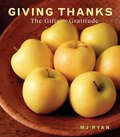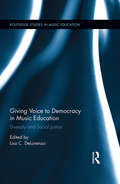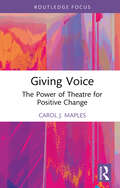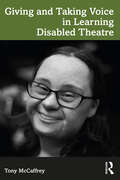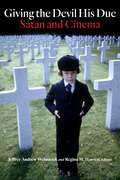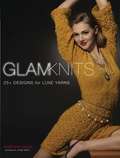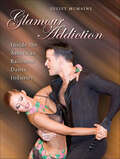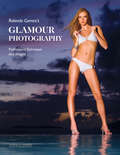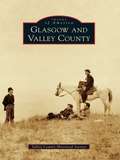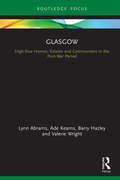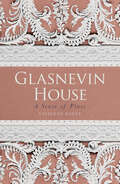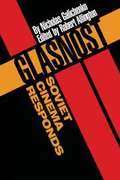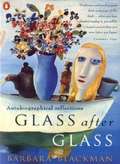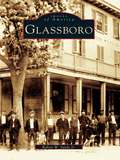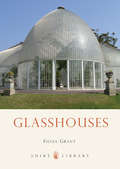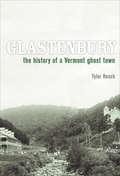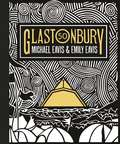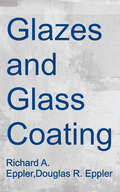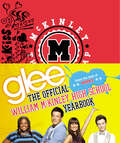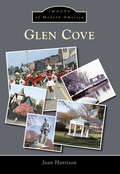- Table View
- List View
Giving Thanks: The Gifts of Gratitude
by M. J. RyanBeautiful photographs and inspiring words that remind us why every day is a gift. Combining the wisdom of her popular book Attitudes of Gratitude with evocative photography, M.J. Ryan explores the many ways of practicing gratitude in our daily lives. When life feels overwhelming, we can easily forget the importance of stopping in the midst of it all and expressing gratitude. Giving Thanks helps us do just that. Through these striking photos and the accompanying text, Giving Thanks reminds us to find the inspirational in the ordinary. Gratitude connects us to others, and feeling gratitude allows us to be our best selves—in good times and in hard times.
Giving Voice to Democracy in Music Education: Diversity and Social Justice in the Classroom (Routledge Studies in Music Education)
by Lisa C. DeLorenzoThis book examines how music education presents opportunities to shape democratic awareness through political, pedagogical, and humanistic perspectives. Focusing on democracy as a vital dimension in teaching music, the essays in this volume have particular relevance to teaching music as democratic practice in both public schooling and in teacher education. Although music educators have much to learn from others in the educational field, the actual teaching of music involves social and political dimensions unique to the arts. In addition, teaching music as democratic practice demands a pedagogical foundation not often examined in the general teacher education community. Essays include the teaching of the arts as a critical response to democratic participation; exploring democracy in the music classroom with such issues as safe spaces, sexual orientation, music of the Holocaust, improvisation, race and technology; and music teaching/music teacher education as a form of social justice. Engaging with current scholarship, the book not only probes the philosophical nature of music and democracy, but also presents ways of democratizing music curriculum and human interactions within the classroom. This volume offers the collective wisdom of international scholars, teachers, and teacher educators and will be essential reading for those who teach music as a vital force for change and social justice in both local and global contexts.
Giving Voice: The Power of Theatre for Positive Change (ISSN)
by Carol J. MaplesThis book is a practical guide for using the power of theatre to address issues of oppression in areas such as race, ethnicity, LGBTQ+, gender, and sexual harassment.Giving Voice charts a roadmap for the process of establishing a troupe, including auditioning members, utilizing authentic source material, directing rehearsals, guiding mindful growth among troupe members, and facilitating an inclusive forum environment. Rooted in Augusto Boal’s Theatre of the Opressed and using the nationally recognized Missouri State University’s Giving Voice troupe as a model, this book provides guidance for customizing the program’s principles to meet the needs of your school, community, organization, or business. Giving Voice forums bring professional development to a new level. Applications include diversity and cultural awareness training in educational settings for students, staff, faculty, and administrators, as well as those in non-profit and for-profit organizations.This book provides a powerful and proven approach to creating a truly inclusive climate. It is a guidebook for accessible use in the secondary and university setting in theatre and performance studies. It has also been shown to be effective for businesses and other organizations.
Giving and Taking Voice in Learning Disabled Theatre
by Tony McCaffreyGiving and Taking Voice in Learning Disabled Theatre offers unique insight into the question of ‘voice’ in learning disabled theatre and what is gained and lost in making performance. It is grounded in the author's 18 years of making theatre with Different Light Theatre company in Christchurch, New Zealand, and includes contributions from the artists themselves. This book draws on an extensive archive of performer interviews, recordings of rehearsal processes, and informal logs of travelling together and sharing experience. These accounts engage with the practical aesthetics of theatre-making as well as their much wider ethical and political implications, relevant to any collaborative process seeking to represent the under- or un-represented. Giving and Taking Voice in Learning Disabled Theatre asks how care and support can be tempered with artistic challenge and rigour and presents a case for how listening learning disabled artists to speech encourages attunement to indigenous knowledge and the cries of the planet in the current socio-ecological crisis. This is a vital and valuable book for anyone interested in learning disabled theatre, either as a performer, director, dramaturg, critic, or spectator.
Giving the Devil His Due: Satan and Cinema
by Jeffrey Andrew Weinstock and Regina M. HansenFinalist, 2021 Bram Stoker Awards (Superior Achievement in Non-Fiction)The first collection of essays to address Satan’s ubiquitous and popular appearances in filmLucifer and cinema have been intertwined since the origins of the medium. As humankind’s greatest antagonist and the incarnation of pure evil, the cinematic devil embodies our own culturally specific anxieties and desires, reflecting moviegoers’ collective conceptions of good and evil, right and wrong, sin and salvation. Giving the Devil His Due is the first book of its kind to examine the history and significance of Satan onscreen. This collection explores how the devil is not just one monster among many, nor is he the “prince of darkness” merely because he has repeatedly flickered across cinema screens in darkened rooms since the origins of the medium. Satan is instead a force active in our lives. Films featuring the devil, therefore, are not just flights of fancy but narratives, sometimes reinforcing, sometimes calling into question, a familiar belief system.From the inception of motion pictures in the 1890s and continuing into the twenty-first century, these essays examine what cinematic representations tell us about the art of filmmaking, the desires of the film-going public, what the cultural moments of the films reflect, and the reciprocal influence they exert. Loosely organized chronologically by film, though some chapters address more than one film, this collection studies such classic movies as Faust, Rosemary’s Baby, The Omen, Angel Heart, The Witch, and The Last Temptation of Christ, as well as the appearance of the Devil in Disney animation.Guiding the contributions to this volume is the overarching idea that cinematic representations of Satan reflect not only the hypnotic powers of cinema to explore and depict the fantastic but also shifting social anxieties and desires that concern human morality and our place in the universe.Contributors: Simon Bacon, Katherine A. Fowkes, Regina Hansen, David Hauka, Russ Hunter, Barry C. Knowlton, Eloise R. Knowlton, Murray Leeder, Catherine O’Brien, R. Barton Palmer, Carl H. Sederholm, David Sterritt, J. P. Telotte, Jeffrey Andrew Weinstock
Glam Knits: 25 Designs for Luxe Yarns
by Stefanie JapelChic Knits for Day and Night When you see glamour, you know it. Whether it's a woman's perfectly tailored clothing, her expertly chosen accessories, or just something about the way she carries herself, true glam is unmistakable. Glam Knitsshowcases 26 totally glam designs, all knit with decadent luxe yarns. Whether you choose to knit a sinfully soft cashmere cardigan, a sparkling silk cami or an eye-catching metallic dress, you'll be the walking definition of glamour when you wear your finished creation. And don't forget to knit that special finishing touch. TheGlam Knitscollection is rounded out with stylish accent pieces like a lacy scarf and a pair of handbags to complete your look. In this follow up to her best-sellingFitted Knits, Stefanie Japel's trademark top-down construction makes the patterns easy to tailor for a perfect fit. All of the patterns are given from extra small to extra large - plus instructions in the front of the book walk you through the ins and outs of modifying a pattern for further easy customization. Go ahead, knit glam. You deserve it.
Glamour Addiction: Inside the American Ballroom Dance Industry
by Juliet McMainsIn the wake of the blockbuster television success of "Dancing with the Stars," competitive ballroom dance has become a subject of new fascination—and renewed scrutiny. Known by its practitioners as DanceSport, ballroom is a significant dance form and a fascinating cultural phenomenon. In this first in-depth study of the sport, dancer and dance historian Juliet McMains explores the "Glamour Machine" that drives the thriving industry, delving into both the pleasures and perils of its seductions. She further explores the broader social issues invoked in American DanceSport: representation of "Latin," economics that often foster inequality, and issues of identity, including gender, race, class, and sexuality. Putting ballroom dance in the larger contexts of culture and history, Glamour Addiction makes an important contribution to dance studies, while giving new and veteran enthusiasts a unique and unprecedented glimpse behind the scenes.
Glamour Photography: Professional Techniques and Images
by Rolando Gomez'SFrom working with models to lighting and posing, everything aspiring glamour photographers need to know in order to run a successful business and take gorgeous pictures is included in this thorough manual. Written for both the amateur and professional photographer, this handbook explores how to build a professional rapport with subjects while creating sensual portraits similar to those found in Maxim, Playboy, and other men’s magazines. Each of the 150 images is accompanied by explanatory text enabling the reader to re-create the shot in its entirety or emulate just some of the picture’s techniques. Tips on adding personality to images, understanding how the body photographs, and taking elegant pictures of fully clothed models is also included.
Glasgow and Valley County
by Valley County Historical SocietyOnce known only as "Siding 45," Glasgow, Montana, was named by a railroad clerk's random finger poke on a spinning globe in 1887. Resourceful land speculators lured its first homesteaders with the promise, "Pin your faith in Glasgow and you shall wear diamonds." Successful farmers and cowboys initially made the community an agricultural center and the seat of Valley County. The 1930s drought and depression eras brought hard times, however, before the construction of the New Deal Fort Peck Dam helped reinvigorate Valley County communities. Faithful to their pioneer legacy, the people of the "Hi-Line" have more recently successfully refocused on long-established agriculture and developing tourism to continue the historic saga of northeast Montana.
Glasgow: High-Rise Homes, Estates and Communities in the Post-War Period (Built Environment City Studies)
by Lynn Abrams Barry Hazley Ade Kearns Valerie WrightIn the wake of an unparalleled housing crisis at the end of the Second World War, Glasgow Corporation rehoused the tens of thousands of private tenants who were living in overcrowded and unsanitary conditions in unimproved Victorian slums. Adopting the designs, the materials and the technologies of modernity they built into the sky, developing high-rise estates on vacant sites within the city and on its periphery. This book uniquely focuses on the people's experience of this modern approach to housing, drawing on oral histories and archival materials to reflect on the long-term narrative and significance of high-rise homes in the cityscape. It positions them as places of identity formation, intimacy and well-being. With discussions on interior design and consumption, gender roles, children, the elderly, privacy, isolation, social networks and nuisance, Glasgow examines the connections between architectural design, planning decisions and housing experience to offer some timely and prescient observations on the success and failure of this very modern housing solution at a moment when high flats are simultaneously denigrated in the social housing sector while being built afresh in the private sector. Glasgow is aimed at an academic readership, including postgraduate students, scholars and researchers. It will be of interest to social, cultural and urban historians particularly interested in the United Kingdom.
Glasnevin House: A Sense of Place
by Vivienne KeelyThe story of Glasnevin House and Demesne, now Holy Faith Convent, is intertwined with the development of the area from the time of the early monks, through the medieval period when it was a farm of Christ Church, to the Georgian building of Mitchell and its nineteenth-century occupancy by the Lindsay family and the Sacred Heart sisters. The story continues with the arrival of the Holy Faith sisters in 1865 and their ongoing stewardship and development of the land. As this book opens with the contemplation of its surroundings, so it closes with the description of the new centre, which draws on natural beauty and the traditional spiritual influences that help us better engage with the modern world.
Glasnost--Soviet Cinema Responds
by Nicholas Galichenko edited by Robert AllingtonWith the coming of glasnost to the Soviet Union, filmmakers began to explore previously forbidden themes, and distributors released films that were suppressed by pre-glasnost-era censors. Soviet cinema underwent a revolution, one that mirrors and helps interpret the social revolution that took place throughout the USSR. Glasnost-Soviet Cinema Responds is the first overall survey of the effects of this revolution on the work of Soviet filmmakers and their films. The book is structured as a series of three essays and a filmography of the directors of glasnost cinema. The first essay, "The Age of Perestroika," describes the changes that occurred in Soviet cinema as it freed itself from the legacy of Stalinism and socialist realism. It also considers the influence of film educator and director Mikhail Romm. "Youth in Turmoil" takes a sociological look at films about youth, the most dynamic and socially revealing of glasnost-era productions. "Odysseys in Inner Space" charts a new direction in Soviet cinema as it focuses on the inner world of individuals. The filmography includes thirty-three of the most significant glasnost-era directors, including Tengiz Abuladze, Karen Shakhnazarov, and Sergei Soloviev, with a comprehensive list of their films. Discussions of many individual films, such as Repentance, The Messenger Boy, and The Wild Pigeon, and interviews with the directors reveal the effects that glasnost and perestroika have had on the directors' lives and art.
Glass After Glass
by Barbara Blackman'One life has many autobiographies. It depends how one sinks one's shaft of remembering. . . ' Barbara Blackman's gift for the feel and weight and place of words, the music of words, draws us into her life as daughter, lover, friend, wife, mother, grandmother. She writes of the wonderful ordinariness of 'household things, children above all, dirty, earthy and high-to-Heaven things. Her portraits of family and friends, many to become among Australia's finest artists, reveal both a delightful sense of the absurd and a great capacity to love. Blind since her early twenties, Blackman writes about the bohemian circles of Australia and London, where she and her artist husband were leading figures.
Glass Becomes Everything: The Art of Dale Chihuly (Fountas & Pinnell Classroom, Guided Reading Grade 6)
by Elizabeth RuschNIMAC-sourced textbook
Glass Painting
by Diana FisherThe beauty of stained glass has been capturing imaginations since the first medieval artists created cathedral windows. Until recently, colored glass creations involved specialized training and equipment. Now there is a new generation of easy-to-use glass paints available that produce lasting works of art with the same vivid, lustrous colors you find in stained glass. In this book, the author shows you in detail how to create your own stunning pieces in a variety of styles and techniques.
Glass in Northwest Ohio
by Quentin R. Skrabec Jr.The discovery of natural gas around Findlay in 1886 started an industrial rush in northwest Ohio. Within five years, over 100 glass companies had moved into the region for free gas and railroad connections to the western markets. Unfortunately the gas ran out in just a few years, and many glass companies moved on, but those that stayed changed the nature of the glass industry forever. A brilliant inventor, Michael Owens of Libbey Glass automated the glass-making process after 3,000 years of no change. His automated bottle-making machine changed American life with the introduction of the milk bottle, beer bottle, glass jar, baby bottle, and soda bottle. It also eliminated child labor in the glass factories. Owens also automated the production of fl at glass by 1920. By 1930, over 85 percent of the world's glass was being produced on the machines of Michael Owens, bestowing the title of "Glass Capital of the World" upon northwest Ohio.
Glassboro (Images of America)
by Robert W. Sands Jr.Glassboro is the first illustrated history of the community whose name pays tribute to the industry that made it what it is today. Filled with treasured memories, the book preserves a remarkable collection of vintage photographs that capture historic Glassboro in the past two centuries as a booming southern New Jersey community at the height of its glass industry. The pages are filled with never-before-published images of the Whitney Glass Works, the Warrick-Stanger Glass Works, the Glassboro Auditorium, the Palace Theatre, and other landmarks from long ago.
Glasshouses
by Fiona GrantThe orangeries and glasshouses that stand in the gardens of many stately homes help to tell a three-century story of garden fashion. They reflect both the architectural and social trends of their time, but above all show an increasing ability to tailor the buildings to the needs of the plants within. Starting with the Restoration fashion for cultivating pineapples, oranges and bananas within palatial orangeries, Fiona Grant then explains the development of glasshouses through the eighteenth century into the heyday of diversification and specialisation that charaterized the Victorian period, to the eventual decline of great glasshouses after the First World War. The role of the glasshouse as a display of status and of an interest in botany, technology and architecture is explored, and the book is colorfully illustrated throughout.
Glastenbury: The History of a Vermont Ghost Town (Brief History Ser.)
by Tyler ReschThe curious history of a tiny town that all but disappeared . . . Includes photos! Founded by a famously scheming New Hampshire governor, Glastenbury struggled for over a century to break triple digits in population. A small charcoal-making industry briefly flourished after the Civil War, yet by 1920 Glastenbury counted fewer than twenty inhabitants. The end came officially in 1937, when the state, following a spirited debate, formally disincorporated the town. Yet Glastenbury&’s legacy lives on in Tyler Resch&’s lively and amusing history. Follow Resch as he chronicles the community&’s compelling, if always precarious, existence. From mysterious murders and curious development schemes to the township&’s eventual annexation by the US Forest Service, Glastenbury tells the ultimately redemptive tale of a community that lost its political status, only to gain a national forest.
Glastonbury 50: The Official Story of Glastonbury Festival
by Emily Eavis Michael EavisTHE SUNDAY TIMES BESTSELLERA BOOK OF THE YEAR PICK IN THE TIMES: 'Captivating'A ROUGH TRADE BOOK OF THE YEAR: 'In-depth and inspiring''Beautifully compiled ... the perfect festival experience' SUNDAY TIMESGlastonbury 50 is the authorised, behind-the-scenes, inside story of the music festival that has become a true global phenomenon. The story begins in 1970. The day after Jimi Hendrix's death... dairy farmer Michael Eavis invites revellers to his field in Somerset to attend a 'Pop, Folk & Blues' festival. Tickets are £1 each, enticing more than a thousand customers with the promise of music, dance, poetry, theatre, lights and spontaneous entertainment - as well as free milk from his own Worthy Farm cows.Fast forward through five tumultuous decades and the Eavis's vision now encompasses a gigantic 'city in the fields', with a total annual population nearing a quarter of a million. Tickets sell out within minutes, the show is beamed live to more than 40 countries around the globe, and over 3 million people are registered to attend. Meanwhile, the bill has expanded to include big name performers, artists and designers from every branch of the creative arts. Glastonbury Festival is now the largest outdoor green fields event in the world.In their own words, Michael and Emily Eavis reveal the stories behind the headlines, and celebrate 50 years of history in the Vale of Avalon. They're joined by a host of big-name contributors from the world of music - among them Adele, JAY-Z, Dolly Parton, Chris Martin, Noel Gallagher, Lars Ulrich and Guy Garvey. They're joined by artists - Stanley Donwood, Kurt Jackson and many more. Writers - Caitlin Moran, Lauren Laverne, Billy Bragg - and by a host of photographers, from Seventies icon Brian Walker to rock and roll legends Jill Furmanovsky and Greg Williams.Together they bring you the magic that makes Glastonbury, Glastonbury.
Glastonbury 50: The Official Story of Glastonbury Festival
by Emily Eavis Michael EavisTHE SUNDAY TIMES BESTSELLERA BOOK OF THE YEAR PICK IN THE TIMES: 'Captivating'A ROUGH TRADE BOOK OF THE YEAR: 'In-depth and inspiring''Beautifully compiled ... the perfect festival experience' SUNDAY TIMESGlastonbury 50 is the authorised, behind-the-scenes, inside story of the music festival that has become a true global phenomenon. The story begins in 1970. The day after Jimi Hendrix's death... dairy farmer Michael Eavis invites revellers to his field in Somerset to attend a 'Pop, Folk & Blues' festival. Tickets are £1 each, enticing more than a thousand customers with the promise of music, dance, poetry, theatre, lights and spontaneous entertainment - as well as free milk from his own Worthy Farm cows.Fast forward through five tumultuous decades and the Eavis's vision now encompasses a gigantic 'city in the fields', with a total annual population nearing a quarter of a million. Tickets sell out within minutes, the show is beamed live to more than 40 countries around the globe, and over 3 million people are registered to attend. Meanwhile, the bill has expanded to include big name performers, artists and designers from every branch of the creative arts. Glastonbury Festival is now the largest outdoor green fields event in the world.In their own words, Michael and Emily Eavis reveal the stories behind the headlines, and celebrate 50 years of history in the Vale of Avalon. They're joined by a host of big-name contributors from the world of music - among them Adele, JAY-Z, Dolly Parton, Chris Martin, Noel Gallagher, Lars Ulrich and Guy Garvey. They're joined by artists - Stanley Donwood, Kurt Jackson and many more. Writers - Caitlin Moran, Lauren Laverne, Billy Bragg - and by a host of photographers, from Seventies icon Brian Walker to rock and roll legends Jill Furmanovsky and Greg Williams.Together they bring you the magic that makes Glastonbury, Glastonbury.
Glazes and Glass Coatings
by Richard A. Eppler Douglas R. EpplerCurrent advances in the formulation and chemical aspects of glazes and glass coatings make this comprehensive resource the most up-to-date reference on glazes for the ceramics industry. By focusing on the process of making ceramic coatings, their chemical makeup, and the properties of these coatings, Glazes and Glass Coatings is a book that will appeal to a wide-ranging audience from industries involved in the manufacturing of tile, ceramic coating materials, sanitaryware, tableware, enameled appliances, hobby and giftware to faculty and students in ceramic engineering, to studio potters. Anyone interested in making or using glazes and glass coatings will value the expertise and wealth of knowledge presented authors by Eppler & Eppler.
Glee: The Official William McKinley High School Yearbook
by Debra Mostow Zakarin The Creators of GleeStraight from Lima, Ohio, The Official William McKinley High School Yearbook is a full-color, completely up-to-date book that captures all the memories of seniors like Rachel Berry, Kurt Hummel, Finn Hudson and their fellow Gleeks. Featuring tons of glossy photos and exclusive images, the one and only OFFICIAL Glee yearbook will transport you to the halls of William McKinley High School. Just be sure to watch out for slushies!
Glen Canyon Dam
by Timothy L. ParksConstructed between 1956 and 1966 by the United States Bureau of Reclamation, Glen Canyon Dam on the Colorado River was a project of immense proportions. Even before the non-stop pouring of 5 million yards of concrete began, much work had to be accomplished. The town of Page, Arizona was established on a windswept mesa to house workers and their families, and the 1,028-foot Glen Canyon Bridge was built to carry men, materials, and equipment to the dam site. Though the dam has proven a controversial structure throughout its history, the massive undertaking of its construction was an undeniable triumph of ingenuity and determination.
Glen Cove
by Joan HarrisonGlen Cove, the only city located on Long Island's Gold Coast, has long been reinventing itself. After World War II, the farms and estates in the area gave way to suburban development. Modern advancements like the zoom lens, the dimmer switch, and X-ray technologies were all developed within the city limits, while factories on the creek supplied the world with carbon paper, typewriter ribbons, and graphic arts film and cameras. Albert Einstein, Nikita Khrushchev, and the Kennedy families stayed in the community, and stars of stage and screen performed about town. In 1968, Glen Cove celebrated its tricentennial. It was followed by urban renewal and the rebuilding of the old downtown. In the final years of the 20th century, the industrial era ended, and under the auspices of Mayor Thomas Suozzi, environmental cleanup and waterfront revitalization began.
